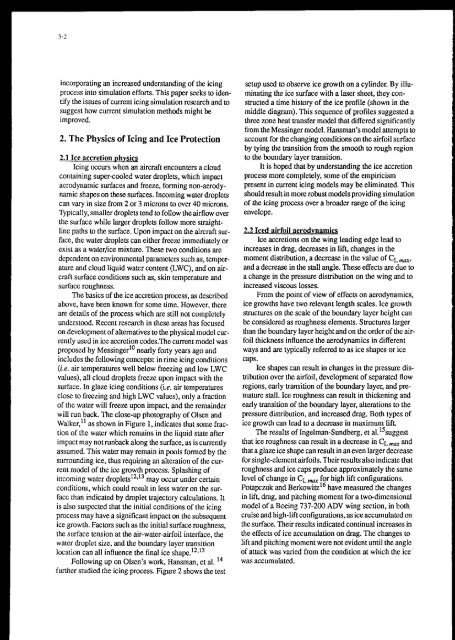Create successful ePaper yourself
Turn your PDF publications into a flip-book with our unique Google optimized e-Paper software.
incorporating an increased understanding of the icing<br />
process into simulation efforts. This paper seeks to iden-<br />
tify the issues of current icing simulation research and to<br />
suggest how current simulation methods might be<br />
improved.<br />
2. The Physics of Icing and Ice Protection<br />
2.1 Ice accretion ohvsics<br />
Icing occurs when an aircraft encounters a cloud<br />
containing supercooled water droplets, which impact<br />
aerodynamic surfaces and freeze, forming non-aerodynamic<br />
shapes on these surfaces. Incoming water droplets<br />
can vary in size from 2 or 3 microns to over 40 microns.<br />
Typically, smaller droplets tend to follow the airflow over<br />
the surface while larger droplers follow more straightline<br />
paths to the surface. Upon impact on the aircraft surface,<br />
the water droplets can either freeze immediately or<br />
exist as a water/ice mixture. These two conditions are<br />
dependent on environmental parameters such as, temperature<br />
and clood liquid water content (LWC), and on aircraft<br />
surface conditions such as, skin temperature and<br />
surface roughness.<br />
The basics of the ice accretion process, as described<br />
above, have been known for some time. However, there<br />
are details of the process which are still not completely<br />
understood. Recent research in these areas has focused<br />
on development of alternatives to the physical model currently<br />
used in ice accretion codes.The current model was<br />
proposed by Messinger" nearly forty years ago and<br />
includes the following concepts: in rime icing conditions<br />
(i.e. air temperatures well below freezing and low LWC<br />
values), all cloud droplets freeze upon impact with the<br />
surface. In glaze icing conditions (Le. air temperatures<br />
close to freezing and high LWC values), only a fraction<br />
of the water will freeze upon impacr and the remainder<br />
will run back. The close-up photography of Olsen and<br />
Walker," as shown in Figure 1, indicates that some fraction<br />
of the water which remains in the liquid state after<br />
impact may not runback along the surface, as is currently<br />
assumed. This water may remain in pools formed by the<br />
surrounding ice, thus requiring an alteration of the current<br />
model of the ice growth process. Splashing of<br />
incoming water dr~plets'~"~ may occur under certain<br />
conditions, which could result in less water on the surface<br />
than indicated by droplet trajectory calculations. It<br />
is also suspected that the initial conditions of the icing<br />
process may have a significant impact on the subsequent<br />
ice growth. Factors such as the initial surface roughness,<br />
the surface tension at the air-water-airfoil interface, the<br />
water droplet size, and the boundary layer transition<br />
location can all influence the final ice<br />
Following up on Olsen's work, Hansman, et al. l4<br />
further studied the icing process. Figure 2 shows the test<br />
setup used to observe ice growth on a cylinder. By illu-<br />
minating the ice surface with a laser sheet, they con-<br />
structed a time history of the ice profile (shown in the<br />
middle diagram). This sequence of profiles suggested a<br />
three zone heat transfer model that differed significantly<br />
from the Messinger model. Hansman's model attempts to<br />
account for the changing conditions on the airfoil surface<br />
by tying the transition from the smooth to rough region<br />
to the boundary layer transition.<br />
It is hoped that by understanding the ice accretion<br />
process more completely, some of the empiricism<br />
present in current icing models may be eliminated. This<br />
should result in more robust models providing simulation<br />
of the icing process over a broader range of the icing<br />
envelope.<br />
2.2 Iced airfoil aerodvnamics<br />
Ice accretions on the wing leading edge lead to<br />
increases in drag, decreases in lift, changes in the<br />
moment distribution, a decrease in the value of CL-.<br />
and a decrease in the stall angle. These effects are due to<br />
a change in the pressure disnibution on the wing and to<br />
increased viscous losses.<br />
From the point of view of effects on aerodynamics,<br />
ice growths have two relevant length scales. Ice growth<br />
structures on the scale of the boundary layer height can<br />
be considered as roughness elements. Structures larger<br />
than the boundary layer height and on the order of the airfoil<br />
thickness influence the aerodynamics in different<br />
ways and are typically referred to as ice shapes or ice<br />
caps.<br />
Ice shapes can result in changes in the pressure distribution<br />
over the airfoil, development of separated flow<br />
regions, early transition of the boundary layer, and premature<br />
stall. Ice roughness can result in thickening and<br />
early transition of the boundary layer, alterations to the<br />
pressure distribution, and increased drag. Both types of<br />
ice growth can lead to a decrease in maximum lift.<br />
The results of Ingelman-Sundberg, et al.'5suggest<br />
that ice roughness can result in a decrease in CL- and<br />
that a glaze ice shape can result in an even larger decrease<br />
for single-element airfoils. Their results alsoindicate that<br />
roughness and ice caps produce approximately the same<br />
level of change in CL- for high lift configurations.<br />
Potapczuk and I3erkowifd6 have measured the changes<br />
in lift, drag, and pitching moment for a two-dimensional<br />
model of a Boeing 737-200 ADV wing section, in both<br />
cruise and high-lift configurations, as ice accumulated on<br />
the surface. Their results indicated continual increases in<br />
the effects of ice accumulation on drag. The changes to<br />
IiCt and pitching moment were not evident until the angle<br />
of attack was varied from the condition at which the ice<br />
was accumulated.

















